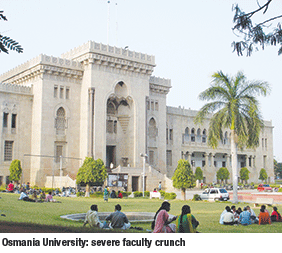Andhra Pradesh: Precipitous decline
THE SHOWPIECE OSMANIA UNIVERSITY, Hyderabad (estb.1918), a prime bone of contention between the feuding protagonists of a breakaway Telangana from Andhra Pradesh (pop. 84 million) and proponents of a unitary state, may not be as valuable a prize as popularly believed. A task force of the Delhi-based University Grants Commission (UGC) which visited and inspected the university in the last week of December confirmed a severe shortage of trained faculty in all departments.
Given that Osmania, ranked among the country’s Top 10 universities (#7) in the India Today league table of 2013, is suffering faculty vacancies because of a severe financial crunch, it’s safe to assume that all universities nationwide — especially state government-funded varsities —are in a similar predicament. That even the small fraction of Indian students in higher education (18 percent cf. global average of 29 percent in the age group 18-23) are denied the benefit of good quality education with adequate infrastructure and a qualified faculty, is ominous for a country in which half the population is below 24 years of age.
According to the UGC task force report which has generated shock waves within academia in Hyderabad, the nutrition department of Osmania University is functioning without a single faculty member, and the psychology department whose sanctioned strength is 11, will soon emulate it when its sole professor retires by end January. Likewise, the department of ancient history, culture and archaeology boasts one professor against the sanctioned faculty of 20; the sociology department has six (sanctioned: 16), public administration nine (20) and geophysics four (24).
Osmania University boasts impressive buildings and infrastructure but lacks qualified staff, seriously impacting the quality of education and research, affirms Prof. B. Satyanarayana, president of the Osmania University Teachers’ Association. “According to Sixth Pay Commission pay scales, a duly qualified professor has to be paid more than Rs.1 lakh per month, associate professor Rs.85,000 and lecturers and readers Rs.40,000 and 70,000 respectively. These pay scales are unaffordable for the state government which is too afraid to raise tuition fees. Therefore the Osmania administration makes do with part-time contract teachers who are paid Rs.21,000 per month, but who seldom have Ph D or NET qualifications. How can we provide quality education in this scenario?” queries Satyanarayana.
With the academic calendar of education institutions — particularly of higher ed institutions — severely disrupted by student agitations for and against the bifurcation of Andhra Pradesh into Telangana and Seemandhra for the past four years and severe faculty shortages in under-funded state government universities and colleges, academics are becoming increasingly anxious about declining standards in Andhra Pradesh. “The block grant of Rs.170.17 crore given by the state government to Osmania University has remained static for the past three years, and at any given point of time government grants are barely enough to cover salaries and pensions of state universities. Currently there is a deficit of Rs.40 crore in meeting expenditure. Since all recruitment is made by the state government which doesn’t fill faculty vacancies as and when they occur because of financial constraints, teaching-learning standards are declining precipitously,” laments Dr. Tirupati Rao, former vice chancellor of the university.
Yet the development experience of universities round the world indicates that they need to reduce government dependency by hiking tuition fees and raising funds from alumni and well-wishers. On these issues, there is silence in Osmania.
Aruna Ravikumar (Hyderabad)















Add comment